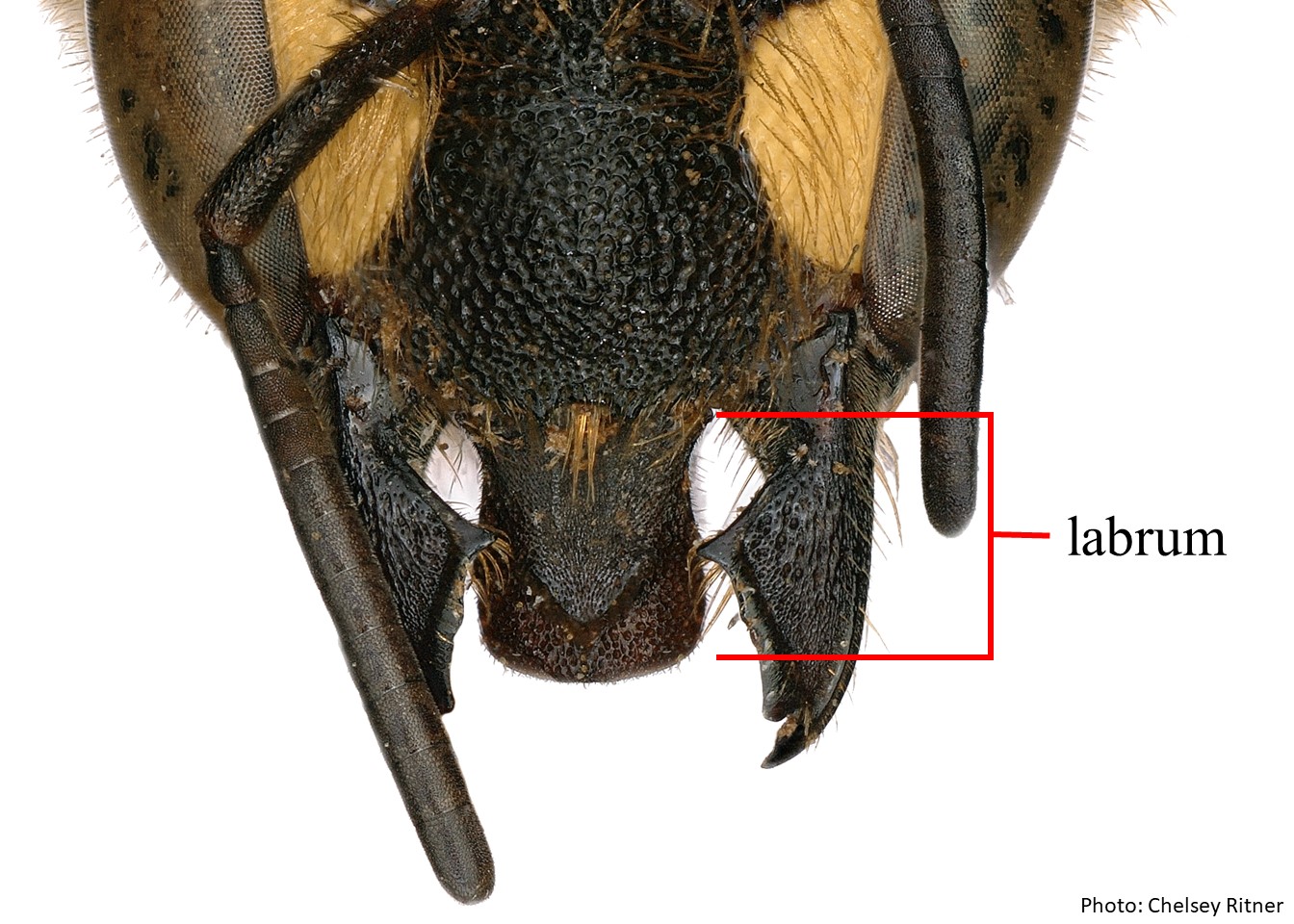Family: Megachilidae
Subfamily: Megachilinae
Tribe: Anthidiini
Genus: Anthidium Fabricius, 1804
Subgenus: A. (Anthidium) Fabricius, 1804
Species: Anthidium pallidiclypeum Jaycox, 1963
Common name: none
Anthidium (Anthidium) pallidiclypeum are dark brown to black with reddish-brown tarsitarsi:
the group of segments at the end of the leg following the tibia
, light brown apicalapical:
near or at the apex or end of any structure
rims of tergaterga:
the segments on the top side of the abdomen, often abbreviated when referring to a specific segment to T1, T2, T3, T4, T5, T6, or T7 , and yellow maculations (Gonzalez and Griswold 2013Gonzalez and Griswold 2013:
, and yellow maculations (Gonzalez and Griswold 2013Gonzalez and Griswold 2013:
Gonzalez, V.H. and T.L. Griswold. 2013. Wool carder bees of the genus Anthidium in the Western Hemisphere (Hymenoptera: Megachilidae): diversity, host plant associations, phylogeny, and biogeography. Zoological Journal 168: 221ndash;425.). Females have white to light ferruginousferruginous:
rust-colored
pubescence that is slightly darker on the vertexvertex:
the area between the ocelli and the back of the head, scutumscutum:
the large segment on top of the thorax located between the wings and behind the head
, axillaaxilla:
the triangular or rounded point on the thorax where thoracic muscles meet the forewing of an insect, scutellumscutellum:
shield shaped plate behind scutum, inner tarsitarsi:
the group of segments at the end of the leg following the tibia
, and S6S6:
the plates on the underside of the abdomen, often abbreviated when referring to a specific segment to S1, S2, S3, S4, S5, S6, S7, or S8
 . Females have a body length of 9.2–13.5 mm, and males range in length from 10.0–12.3 mm (Gonzalez and Griswold 2013Gonzalez and Griswold 2013:
. Females have a body length of 9.2–13.5 mm, and males range in length from 10.0–12.3 mm (Gonzalez and Griswold 2013Gonzalez and Griswold 2013:
Gonzalez, V.H. and T.L. Griswold. 2013. Wool carder bees of the genus Anthidium in the Western Hemisphere (Hymenoptera: Megachilidae): diversity, host plant associations, phylogeny, and biogeography. Zoological Journal 168: 221ndash;425.).
(modified from Gonzalez and Griswold 2013Gonzalez and Griswold 2013:
Gonzalez, V.H. and T.L. Griswold. 2013. Wool carder bees of the genus Anthidium in the Western Hemisphere (Hymenoptera: Megachilidae): diversity, host plant associations, phylogeny, and biogeography. Zoological Journal 168: 221ndash;425.)
 is basally elevated with two large preapicalpreapical:
is basally elevated with two large preapicalpreapical: lacks laterallateral:
lacks laterallateral: with median apicalapical:
with median apicalapical: .
. apicalapical:
apicalapical: lacks laterallateral:
lacks laterallateral: is truncatetruncate:
is truncatetruncate: apicalapical:
apicalapical: laterallateral:
laterallateral: median spine.
median spine. laterallateral:
laterallateral:Anthidium pallidiclypeum may be confused with A. edwardsii and A. placitum because of the distinctly concave apicalapical:
near or at the apex or end of any structure
margin of the clypeusclypeus:
a section of the face below the antennae, demarcated by the epistomal sutures. The clypeusclypeus:
a section of the face below the antennae, demarcated by the epistomal sutures of A. pallidiclypeum differs from these other species in that it lacks strong sub-lateral projections on the apicalapical:
near or at the apex or end of any structure
margin (Gonzalez and Griswold 2013Gonzalez and Griswold 2013:
Gonzalez, V.H. and T.L. Griswold. 2013. Wool carder bees of the genus Anthidium in the Western Hemisphere (Hymenoptera: Megachilidae): diversity, host plant associations, phylogeny, and biogeography. Zoological Journal 168: 221ndash;425.). Male A. pallidiclypeum can be distinguished by the reddish-brown median apicalapical:
near or at the apex or end of any structure
brush on S4S4:
the plates on the underside of the abdomen, often abbreviated when referring to a specific segment to S1, S2, S3, S4, S5, S6, S7, or S8
 , the shape of the T7T7:
, the shape of the T7T7:
the segments on the top side of the abdomen, often abbreviated when referring to a specific segment to T1, T2, T3, T4, T5, T6, or T7 laterallateral:
laterallateral:
relating, pertaining, or attached to the side
lobes, and the bifidbifid:
divided into two branches; forked
apicalapical:
near or at the apex or end of any structure
process of S8S8:
the plates on the underside of the abdomen, often abbreviated when referring to a specific segment to S1, S2, S3, S4, S5, S6, S7, or S8
 having clubbed ends (Gonzalez and Griswold 2013Gonzalez and Griswold 2013:
having clubbed ends (Gonzalez and Griswold 2013Gonzalez and Griswold 2013:
Gonzalez, V.H. and T.L. Griswold. 2013. Wool carder bees of the genus Anthidium in the Western Hemisphere (Hymenoptera: Megachilidae): diversity, host plant associations, phylogeny, and biogeography. Zoological Journal 168: 221ndash;425.).
Anthidium pallidiclypeum adults have been recorded in flight from late April to early July, with peak activity occurring from the last half of May to the first half of June (Gonzalez and Griswold 2013Gonzalez and Griswold 2013:
Gonzalez, V.H. and T.L. Griswold. 2013. Wool carder bees of the genus Anthidium in the Western Hemisphere (Hymenoptera: Megachilidae): diversity, host plant associations, phylogeny, and biogeography. Zoological Journal 168: 221ndash;425.).
Anthidium pallidiclypeum is a generalist that has been observed visiting a variety of species within Asteraceae, Boraginaceae, Cactaceae, Fabaceae, Lamiaceae, Plantaginaceae, Polygonaceae, Ranunculaceae, and Rhamnaceae (Gonzalez and Griswold 2013Gonzalez and Griswold 2013:
Gonzalez, V.H. and T.L. Griswold. 2013. Wool carder bees of the genus Anthidium in the Western Hemisphere (Hymenoptera: Megachilidae): diversity, host plant associations, phylogeny, and biogeography. Zoological Journal 168: 221ndash;425.).
Nesting behavior is unknown.
Anthidium pallidiclypeum occur in the U.S. in California and southern Nevada. They are restricted to mountainous areas of the Mojave Desert, California chaparral and woodlands, and southeastern Great Basin shrub steppe ecosystems. In Mexico, they are commonly found in Baja California (Gonzalez and Griswold 2013Gonzalez and Griswold 2013:
Gonzalez, V.H. and T.L. Griswold. 2013. Wool carder bees of the genus Anthidium in the Western Hemisphere (Hymenoptera: Megachilidae): diversity, host plant associations, phylogeny, and biogeography. Zoological Journal 168: 221ndash;425.).
Distribution map generated by Discover Life -- click on map for details, credits, and terms of use.
Gonzalez, V.H. and T.L. Griswold. 2013. Wool carder bees of the genus Anthidium in the Western Hemisphere (Hymenoptera: Megachilidae): diversity, host plant associations, phylogeny, and biogeography. Zoological Journal of the Linnean Society 168: 221-425.